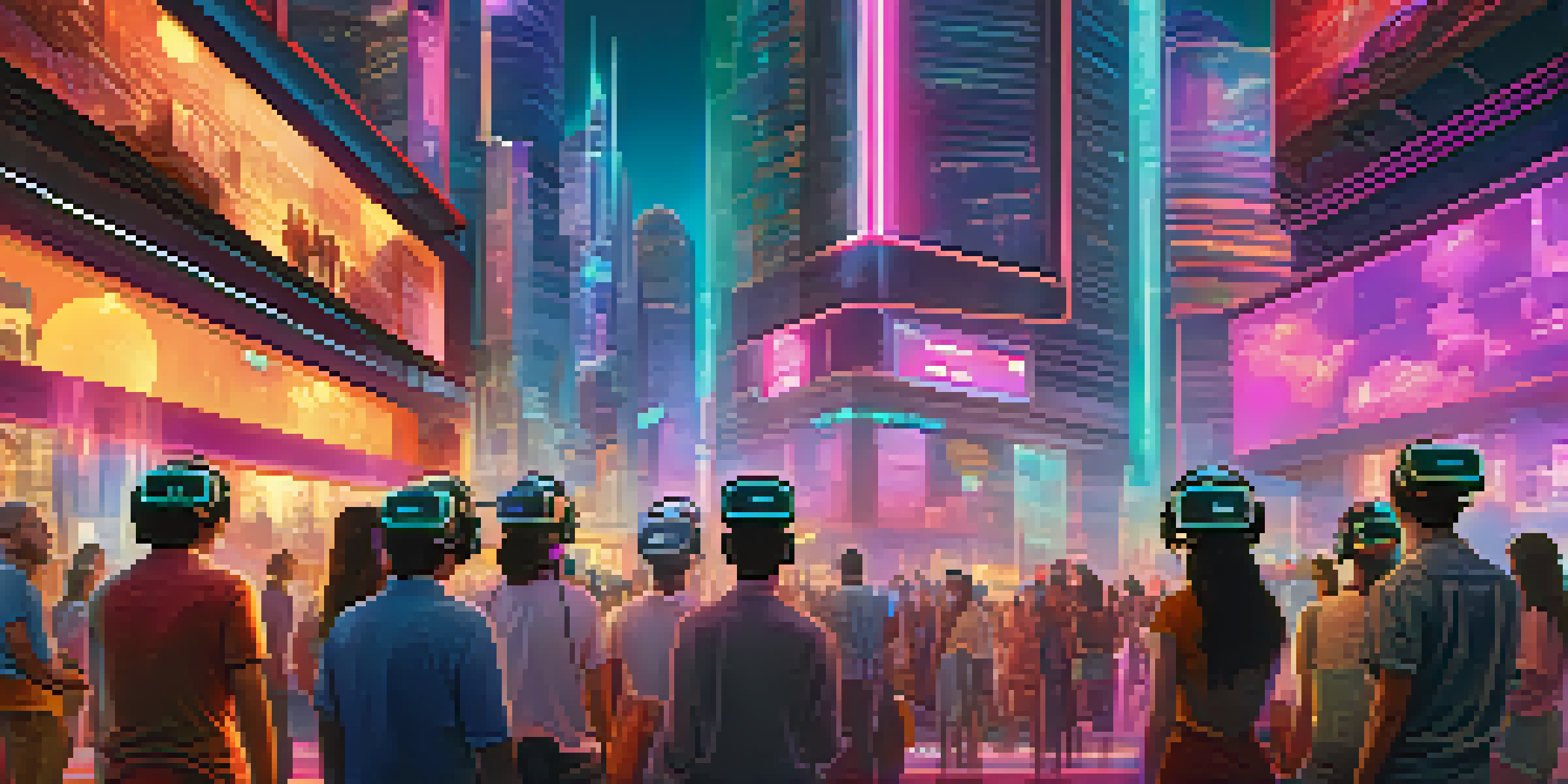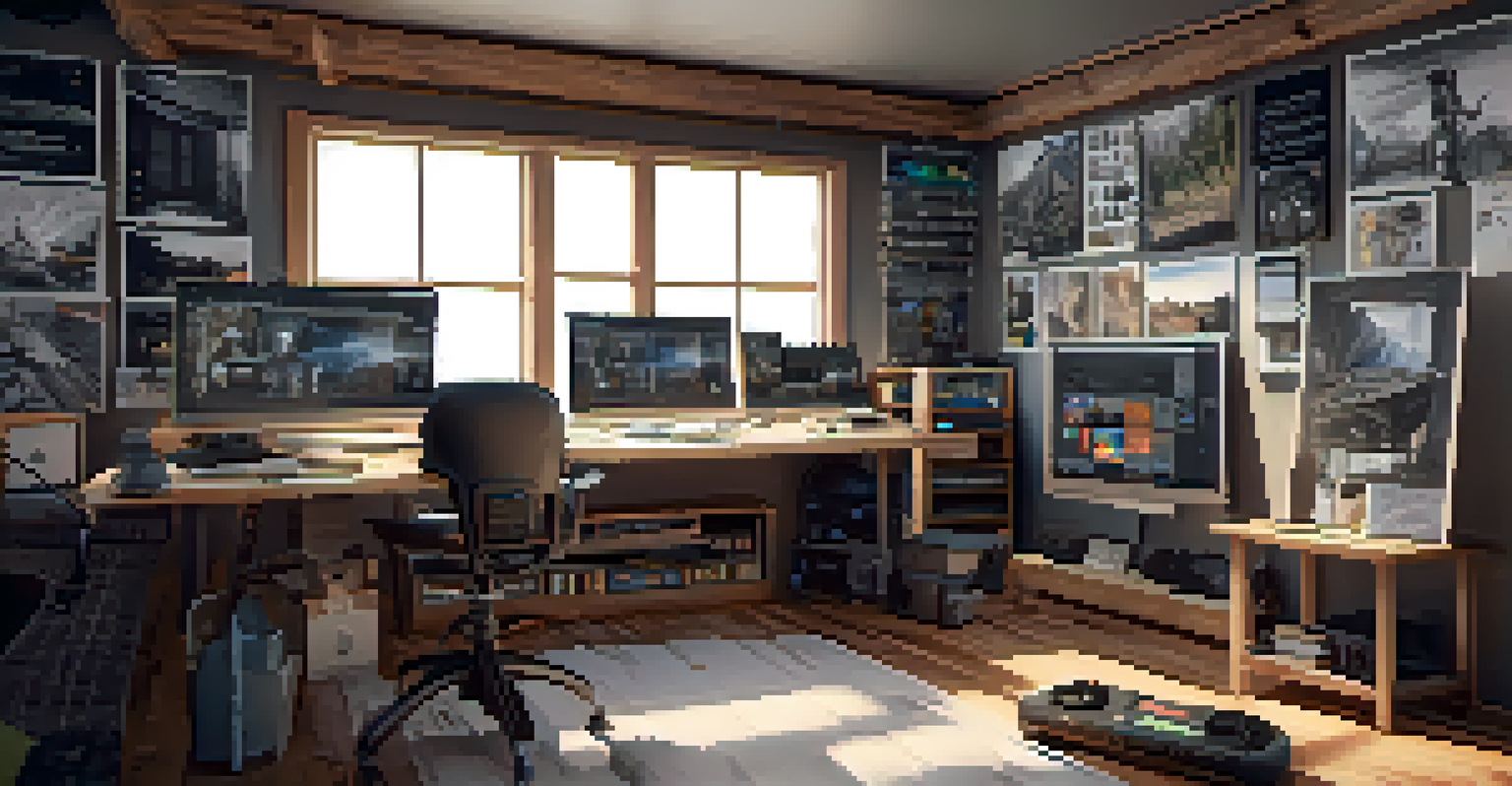Virtual Reality: A Game-Changer for Hollywood Productions

Understanding Virtual Reality in Film Production
Virtual reality (VR) is more than just an engaging gaming experience; it's a revolutionary tool shaping the film industry. By immersing audiences in a 360-degree environment, filmmakers can transport viewers to other worlds, creating a more engaging and memorable experience. This technology allows for a new level of storytelling, where the viewer can influence their journey through the narrative.
Virtual reality is the next best thing to being there.
The use of VR in film production isn't just about flashy visuals; it's about deepening the emotional connection between the audience and the story. Imagine watching a scene unfold around you, feeling as if you're part of the action. This immersive experience can enhance empathy, making viewers feel the highs and lows of the characters like never before.
As Hollywood embraces VR, it's clear that this technology is set to redefine how stories are told. By leveraging VR, filmmakers can push creative boundaries and explore new storytelling methods, paving the way for a future where traditional filmmaking and virtual experiences blend seamlessly together.
Enhanced Pre-Production with Virtual Reality
One of the most significant advantages of VR is its impact on pre-production processes. Directors and cinematographers can use VR simulations to visualize scenes before a single frame is shot, allowing them to plan camera angles, lighting, and set designs more effectively. This immersive planning stage can save time and resources on set, leading to a smoother production process.

For instance, VR can help teams conceptualize complex action sequences or intricate set pieces, ensuring everyone is on the same page before filming begins. By walking through virtual sets, crew members can identify potential issues and refine their approaches, reducing the likelihood of costly mistakes during actual filming.
VR Transforms Film Storytelling
Virtual reality immerses audiences in a 360-degree environment, enhancing emotional connections and allowing for interactive storytelling.
Ultimately, this innovative approach to planning not only streamlines production but also fosters collaboration among the creative team. With everyone working from a shared vision, the likelihood of achieving the desired final product increases significantly.
Innovative Storytelling Techniques with VR
Virtual reality opens up a treasure trove of storytelling possibilities that traditional films can't match. Imagine being able to choose your path through a narrative, much like a choose-your-own-adventure book, but with a fully immersive experience. This shift allows for interactive storytelling, where the audience is no longer a passive observer but an active participant.
The only limit to our realization of tomorrow will be our doubts of today.
For example, films like 'The Invisible Man' have experimented with VR, allowing viewers to experience the story from different character perspectives. This not only enhances engagement but also encourages multiple viewings, as audiences will want to explore different outcomes and experiences.
As filmmakers continue to explore this new medium, we're likely to see even more innovative ways to tell stories. The blend of VR technology with traditional storytelling techniques creates a unique dynamic that can captivate audiences in ways we've never seen before.
Cost Efficiency and Practical Effects in Filmmaking
While it may seem counterintuitive, using VR can lead to significant cost savings in film production. By creating virtual sets and environments, filmmakers can reduce the need for extensive physical sets and location shoots, which can be time-consuming and expensive. This shift not only cuts costs but also allows for greater creative freedom.
Moreover, VR enables filmmakers to experiment with practical effects in ways that were previously impossible. For instance, complex stunts or special effects can be simulated in the virtual realm, allowing filmmakers to visualize how they might look in the final cut. This can help in planning shots more effectively and reducing the risks associated with live-action stunts.
Streamlined Pre-Production with VR
Using VR in pre-production enables filmmakers to visualize scenes and plan effectively, saving time and resources on set.
In essence, the use of VR can streamline production while also providing a playground for creativity. By offering budget-friendly solutions without sacrificing quality, filmmakers can focus on what truly matters: telling compelling stories.
Audience Engagement through Immersive Experiences
One of the most exciting aspects of VR is its potential for audience engagement. By offering immersive experiences, filmmakers can create a stronger connection between the viewer and the story. Imagine not just watching a film but feeling as if you're walking alongside the characters, experiencing their struggles and triumphs firsthand.
This level of engagement can transform the way audiences consume content. Instead of simply sitting back and watching, viewers become part of the narrative, fostering a deeper emotional connection that can lead to lasting impressions. This change in how we interact with stories could redefine audience expectations and experiences in cinema.
As filmmakers continue to innovate with VR, the possibilities for audience engagement are virtually limitless. By breaking down the fourth wall, they can craft experiences that resonate on a personal level, making each viewing unique and memorable.
The Rise of VR Content Creation in Hollywood
As virtual reality continues to gain traction, we're witnessing a surge in VR content creation in Hollywood. More filmmakers are experimenting with this technology, producing short films and immersive experiences tailored specifically for VR platforms. This shift is not just a trend; it's a new avenue for storytelling that resonates with modern audiences.
For instance, platforms like Oculus and Viveport are showcasing a variety of VR films, inviting viewers to step into a new realm of entertainment. This growing market encourages filmmakers to hone their skills in creating engaging VR content, which can set them apart in a competitive industry.
Growing Demand for VR Content
The rise of VR content creation in Hollywood indicates a shift towards innovative storytelling methods that resonate with modern audiences.
The rise of VR content creation signifies a broader transformation in Hollywood, where traditional boundaries are being pushed. As more creators embrace this technology, we're likely to see a plethora of innovative stories that challenge our perceptions of film and entertainment.
Challenges and Considerations for VR in Film
Despite its many advantages, incorporating VR into film production comes with its own set of challenges. One major concern is the technology's accessibility; not everyone owns a VR headset, which could limit potential audience reach. Filmmakers must consider how to ensure their content is available to a broader audience while still delivering an immersive experience.
Additionally, the learning curve associated with VR technology can be steep for both filmmakers and audiences. Writers, directors, and crew members need to familiarize themselves with the nuances of VR storytelling, which differs significantly from traditional film techniques. This adaptation requires time and investment in training and development.

Ultimately, while the challenges are notable, they are not insurmountable. As the industry evolves, solutions will emerge, allowing filmmakers to harness the full potential of VR while addressing these concerns head-on.
The Future of Virtual Reality in Hollywood
Looking ahead, the future of virtual reality in Hollywood appears bright and full of potential. As technology continues to advance, we can expect even more sophisticated VR experiences that enhance storytelling. The integration of artificial intelligence and interactive elements will likely push the boundaries of what’s possible in film.
Moreover, as audiences become more accustomed to VR content, the demand for innovative experiences will grow. Filmmakers who embrace this change will have the opportunity to capture the hearts and minds of viewers in fresh and exciting ways, ultimately reshaping the entertainment landscape.
In conclusion, virtual reality is not just a passing fad; it's a game-changer for Hollywood productions. As we witness this evolution, it will be fascinating to see how VR continues to influence the way stories are told and experienced on the big screen.